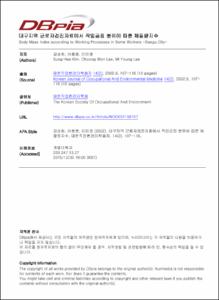KUMEL Repository
1. Journal Papers (연구논문)
1. School of Medicine (의과대학)
Dept. of Preventive Medicine (예방의학)
대구지역 근로자검진자료에서 작업공정 분류에 따른 체질량지수
- Keimyung Author(s)
- Lee, Choong Won; Lee, Mi Young
- Department
- Dept. of Preventive Medicine (예방의학)
- Journal Title
- 대한산업의학회지
- Issued Date
- 2002
- Volume
- 14
- Issue
- 2
- Abstract
- Objectives: This study was carried to survey obesity and to screen high risk working processes related to obesity in the workplace.
Methods: In 1999, a total of 12,518 workers (men 8,379, women 4,139) residing in Daegu underwent an annual health examination at the Dongsan Medical Center. Grade of obesity was classified using body mass index (BMI) according to the following criteria; underweight ( <18.5), normal (19-22.9), overweight (23.0-24.9), mild obesity (25-29.9), severe Obesity ( >30.0). One industrial hygienist classified the working processes.
Results: The BMI mean and standard error was 22.63±0.03 in men and 22.18±0.04 in women. Age was a strong indicator of obesity, which peaked at 50-54 years old in men and over 60 years old in women. After adjustment for age by ANCOVA, the working process showing the highest BMI for men was ‘Sales’, at 23.93±0.18 while the lowest was ‘Mill rolling’, at 21.49±0.27. For Women ‘Foundry·Molding’, at 22.84±0.49 was the highest while ‘Office work’, 21.78±0.12 was the lowest.
Conclusions: Physical activities at work were inversely related to BMI in men but, were directly related in women. Women, over 50 years old and working in the process demanding high physical activity were the group most susceptible to obesity.
Key Words: Body Mass index, Effect Modification
목적: 사업장에 근무하는 근로자들의 체질량지수의 평균를 작업공정별로 평가하여 비만도의 수준을 추정하고 개입을 위한 고 위험 집단을 찾아내고자 하였다.
방법: 대상자는 계명대학교 동산의료원 산업의 학과에서 199년 1년간 건강검진을 받은 근로자이다. 신장과 체중은 상의와 신발을 벗은 상태에서 비만측정기 (FA-94H, 한국)를 이용하여 측정하였다. 비만도는 BMI(Body Mass Index)로 계산하였으며, 아시아 성인의 기준에 따라 저체중( <08.5), 정상(18.5-22.9), 과체중(23.0-24.9), 경도비만(25.1-29.9), 고도비만( >30.0)으로 분류하였다. 대상자의 작업공정 분류는 한국산업안전공단에서 발간한 “근로자 건강진단 및 작업환경측정 전산업무 관련 코드집 (1999)”을 참고하여 기술사 1명이 하였다.
결과: 분석 대상자는 남자 8,379명, 여자 4,139명으로 총 12,518명이었다. 남자에서 체질량지수의 평균±표준오차는 22.63±0.03, 여자에서 22.18±0.04였으며 남녀 모두에서 연령에 따라 증가하여 남자는 50-54세, 여자는 60세 이상에서 정점을 나타내었다. 공분산분석(ANCOVA)으로 연령을 통제한 후 작업공정별 체질량지수를 비교해 본 결과 남자에서는 영업직이 23.93±0.18로 가장 높았으며 압연·인발·압출 공정이 21.49±0.278로 가장 낮았다. 여자에서는 조형·주물 공정이 가장 높아 22.84±0.49를 나타내었으며 사무직이 22.84±0.49로 가장 낮았다.
결론: 남녀 모두에서 연령의 증가에 따라 체질량지수가 증가함을 알 수 있었으며, 공정별로 작업중 신체활동량이 증가할수록 남자는 체질량지수가 감소하고 여자는 증가하는 반대의 결과를 나타내었다. 연령과 작업공정을 고려할 때, 사업장에서 우선적인 고 위험군은 40대 후반 이후의 작업시 신체활동량이 많은 여성근로자라고 할 수 있다.
- Alternative Title
- Body Mass Index according to Working Processes in Some Workers -Daegu City-
- Publisher
- School of Medicine
- Citation
- 김성희 et al. (2002). 대구지역 근로자검진자료에서 작업공정 분류에 따른 체질량지수. 대한산업의학회지, 14(2), 107–116.
- Type
- Article
- ISSN
- 1225-3618
- Appears in Collections:
- 1. School of Medicine (의과대학) > Dept. of Preventive Medicine (예방의학)
- 파일 목록
-
-
Download
 oak-bbb-1979.pdf
기타 데이터 / 1.12 MB / Adobe PDF
oak-bbb-1979.pdf
기타 데이터 / 1.12 MB / Adobe PDF
-
Items in Repository are protected by copyright, with all rights reserved, unless otherwise indicated.